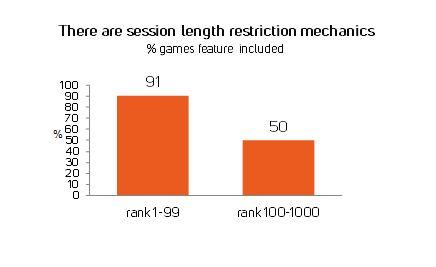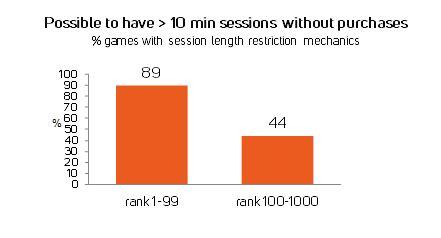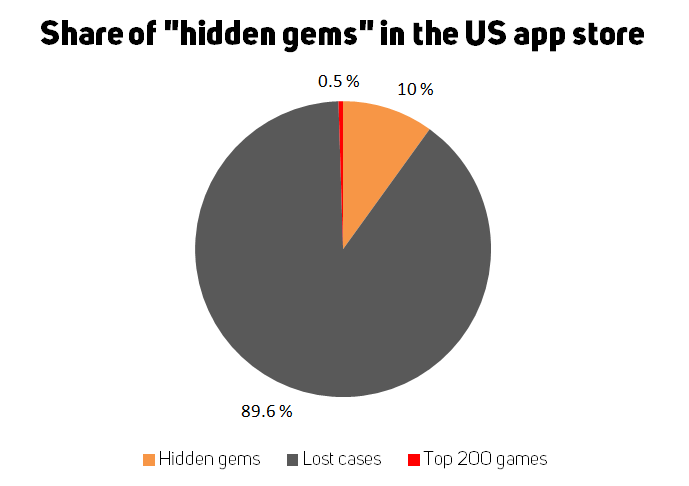When free-to-play games conquered the mobile game industry and invaded the top grossing charts, they also brought along a concept that caused some turmoil in the gaming scene. We’re of course talking about session length restriction, a controversial feature that makes many veteran gamers grimace in disgust. Under this new regime of free-to-play, players are often forced to wait (or pay) in order to enjoy their favorite games – a concept that was – and still is – very hard for many of us to approve of.
The thing is, however, that whether we like it or not, session length restriction has become an essential characteristic of mobile games and this trend doesn’t show any signs of weakening. So the question is, how should you take it into account when designing your next free-to-play title?
1. You should implement it – even if you hate it
The usual argument against session length restriction mechanisms is that it kills the joy of playing and sucks the fun out of any game. However, in the top grossing charts, the vast majority of games have embraced this feature, and only a few can hold the highest rankings without it. As free-to-play has established itself as the new mainstream of the industry, players have slowly started to accept session length restrictions as a status quo.
Actually, many casual and mid-core players don’t seem to deter session length restriction with the same passion as players with experience from PC and console world. Typically, mobile games are enjoyed in brief 5-15 min sessions – they are often just a way to pass time in a bus or in a queue for a cup of coffee, not a way to spend the whole afternoon. Therefore, a forced waiting time every now and then is not usually considered to be the end of the world. It has even been said, that without energy mechanics, some games would become boring and run out of content very fast (Deconstructor of Fun: Six Rules of a Hit Puzzle Game).
As an addition to these arguments, objective data from our database tips the scales in favor of session length restriction. In the graph below, you can see statistical indication that in today’s markets, the implementation of session length restriction elements is a differentiating factor between the most successful and the not so successful mobile games.

However, if you don’t know exactly how to implement session length restriction mechanisms to your game, things can go south pretty fast. To avoid this, you should…
2. Know which restriction method suits your game the best
There are different ways to do it, but the following three methods seem to triumph at the moment:
Energy – Every time you do something (enter a dungeon, try a level etc.), you lose energy. Once your energy is fully depleted, you have to wait for it to replenish before you can continue playing. In games where the player or his characters gain exp, find items and progress in a single, continuous string of events, this method is a very natural choice, as it helps to maintain session lengths constantly at the same approximate level and “guarantees” the player enough time to have an enjoyable experience in one sitting. It is, therefore, no surprise that this method is often seen in successful RPG’s, CCG’s and match 3 puzzle games with some level of character development.

Lives – Every time you fail, you lose a life. If you don’t have lives, you can’t play. This method differs from the previous one in the sense that it only “punishes” you for failed attempts. By using life mechanics, players can sometimes be allowed to enjoy long uninterrupted runs, but also be subjected to frustratingly short sessions with clever (and fiendish) level design. This partly explains why lives are such an excellent way of restricting session length in games, where randomness and luck are a major factor. If you mix that with zero amount of character/ player progression (exp) and the idea that every level is its own separate challenge, you start to understand why so many casual match 3 puzzlers use this method.

Wait-to-finish – When you upgrade, build, train or engage in some other core activity of the game, you are required to wait a certain (usually exponentially increasing) amount of time. Building focused strategy and tapping games are typical representatives of this restriction method, but other genres also use wait-to-finish to slow down players’ progression in some areas of the game (still waiting for those rifle and engine upgrades to finish…). Just like with the other two methods, players are encouraged to pay up in order to avoid frustrating waiting. However, unlike the other two methods, wait-to-finish guarantees you a certain progress in return for your money. For example, even if you spend your monthly salary to buy lives in Candy Crush, you can still end up where you started. In Clash of Clans, the same amount of dollars will reward you with at least some level of progression and you know exactly the outcome achieved through the purchase. That’s why wait-to-finish fits well in games where luck and randomness have only minimal roles.

3. Don’t overdo it!
Mobile games should first and foremost be about one thing – fun. Even if session length restriction mechanisms can boost your title’s commercial potential, they come with the significant risk of replacing every last bit of joy with frustration and fury. If the player is forced to use his/her money in every twist and turn, the term “free to play” turns to a bad joke. There are many examples of games overdoing session length restriction, alienating their user base and losing a lot of potential revenue in the process.
Finding the right balance is of course very case dependent, but a good rule of thumb seems to be the following:
An average player should be able to have at least 10 minute gaming session in one sitting, without having to use the money or in-game currency. This statement could be backed up by actual data from our database:

As you can see, games that don’t put too tight leash on the session length tend to have better chances in the top grossing lists.
To sum it up, a well-balanced restriction mechanism can be an excellent servant for your game and boost its commercial potential tremendously. However, it makes a very poor master and will happily ruin your game’s chances of success if given the chance.




















